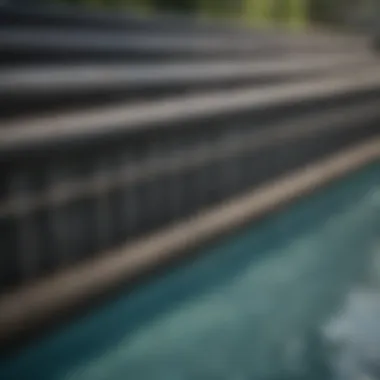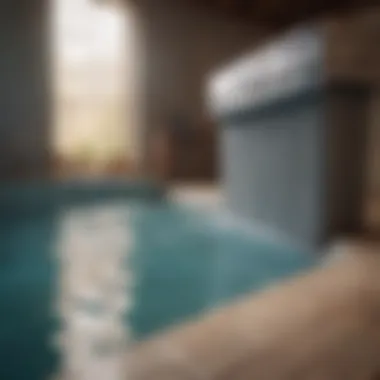In-Ground Cartridge Pool Filters: A Comprehensive Guide


Overview of Topic
In-ground cartridge pool filters are a cornerstone of modern pool maintenance, offering a blend of efficiency, convenience, and effectiveness. Unlike their sand and diatomaceous earth counterparts, cartridge filters are designed to trap particles without much hassle. They utilize disposable or reusable filter cartridges that can be cleaned easily. Over the years, these filters have garnered preference for not only keeping pools crystal clear but also for being less demanding in terms of upkeep.
Understanding the significance of in-ground cartridge filters is crucial for homeowners who want to invest wisely in their pool care. A properly functioning filter helps maintain water clarity, reduces chemical usage, and in the long run, keeps maintenance costs down. With people spending more time at home and investing in quality leisure amenities, choosing the right filter is essential.
Common Challenges and Solutions
However, as with any home improvement endeavor, challenges exist in the realm of pool filters. Some common issues faced by homeowners include:
- Clogged Filters: Debris and particles can accumulate in the filter, leading to reduced efficiency.
- Size Mismatch: An incorrectly sized filter may not handle the volume of water effectively, either being oversized or undersized.
- High Maintenance Needs: While cartridge filters require less maintenance than some alternatives, over time, they can become a chore if not managed properly.
Solutions and Tips
Overcoming these challenges can be done with a little bit of knowledge and planning:
- Regular Cleaning: Periodic cleaning of the cartridges will minimize clogs. Rinse cartridges with a garden hose and consider soaking them in a cleaning solution every few months.
- Size it Right: When purchasing, ensure you know your pool's specifications. Calculate the flow rate to find a filter that matches your pool's needs.
- Maintenance Schedule: Set a timeline for inspections, cleaning, and replacement of the cartridges so that they don’t sneak up on you. This can help ensure everything runs smoothly.
To maintain your pool effectively, it's not just about the filter. Regular maintenance plays a key role in keeping your water clean and safe.
Product Recommendations
When it comes down to selecting a filter, it's advisable to consider a few brands that consistently receive high marks from pool owners. Here are some top picks:
- Pentair Clean & Clear Plus: Known for efficient filtering and user-friendliness, this product has a large filter area for better dirt-holding capacity, making maintenance less frequent.
- Hayward SwimClear: Offering robust filtration with a wide cartridge, it ensures minimal pressure loss and a longer cleaning cycle.
- Intex 28633EG: Ideal for above-ground pools as well, it's often favored due to its affordable pricing and ease of use.
Benefits and Features
Each of these products has features tailored to various needs. For instance:
- Pentair Clean & Clear Plus provides a corrosion-resistant tank, ensuring durability.
- Hayward SwimClear has a large dirt capacity, which means less frequent cartridge replacements.
- Intex's model is especially suited for budget-conscious consumers, offering solid performance without breaking the bank.
Step-by-Step Guides
Getting the most out of your in-ground cartridge pool filter involves both installation and ongoing maintenance. Here’s how to go about it:
- Installation: Ensure you follow manufacturer guidelines. Typically, you'll need to position the filter near the pool pump.
- Routine Maintenance: Here, a simple checklist might help:
- Seasonal Checks: At the start of each pool season, inspect your system for any worn parts, ensuring all is well before diving in. Keep an eye out for any wear in hoses or filtration areas.
- Measure and prepare the site.
- Connect the inlet and outlet hoses, ensuring there are no leaks.
- Inspect the cartridges every two weeks for debris.
- Clean them using a hose or a cartridge cleaner as needed.
- Replace if they become damaged or too dirty.
Understanding Pool Filtration Systems
An in-ground swimming pool can be a source of relaxation and joy for families, but maintaining its cleanliness is a different ball game. One of the essential elements in achieving a well-maintained pool is understanding pool filtration systems. Filtration is not just a technical jargon; it lies at the heart of what makes a pool safe and inviting. This section will delve into the importance of filtration systems and their differing types, and why they are pivotal in ensuring enduring enjoyment for pool owners.
The Role of Filtration in Pool Maintenance
Filtration serves as the backbone of pool maintenance. Its primary role is to remove debris, dirt, and contaminants from the water, keeping it clear and healthy. Think of it as the pool's respiratory system. A well-functioning filter captures leaves, hair, and other small particles that can quickly turn a sparkling oasis into a murky mess. Without an effective filtration system, pools can become breeding grounds for bacteria and algae, leading to potential health risks for swimmers.
Moreover, regular use of a filtration system can drastically reduce the need for harsh chemicals that can affect water quality. It's not merely about cleanliness; it's about providing a safe environment for family and friends. Regular filtration aids in maintaining chemical balance, meaning fewer headaches for pool owners when it comes to monitoring pH levels.
Types of Pool Filters Explained
When it comes to pool filtration systems, a few main types stand out, each with its unique mechanisms and features. Below is a breakdown of these systems:
Sand Filters
Sand filters are one of the oldest and most popular forms of pool filtration. They work by passing water through a tank filled with specially graded sand. As water flows through, contaminants are trapped in the sand while the clean water returns to the pool.
Key Characteristics:
The primary benefit of sand filters is their simplicity and ease of use. They typically require less frequent maintenance compared to other types. The unique feature of sand filters is their longevity; with proper care, the sand can last for several years before needing replacement.
Advantages:
- Easy to operate
- Cost-effective initial investment
- Less frequent backwashing required
Disadvantages:
- May not filter out the tiniest particles
- Requires backwashing to maintain efficiency
Diatomaceous Earth Filters
Diatomaceous earth filters utilize fine powder made from the fossilized remains of tiny aquatic organisms. Water flows through the diatomaceous earth, which acts like a fine mesh and captures even the smallest particles.
Key Characteristics:
Diatomaceous earth filters are celebrated for their filtering ability and deliver crystal-clear water that many pool owners desire. However, they require a bit more work in setup and maintenance than sand filters.
Advantages:
- Exceptional filtration quality
- Can capture particles as small as 3-5 microns
Disadvantages:
- More expensive than sand filters
- More complicated to maintain
Cartridge Filters
Cartridge filters offer a middle ground between sand and diatomaceous earth filters. They utilize a replaceable cartridge to filter out debris and contaminants from the pool water. The water is forced through the cartridge, which traps particles before circulating back into the pool.


Key Characteristics:
One major appeal of cartridge filters is their ease of use. They require less frequent cleaning than sand filters, translating to less time spent on maintenance for pool owners.
Advantages:
- Easy to clean and maintain
- No need for backwashing, saving water
- Efficient at capturing particles
Disadvantages:
- Cartridges must be replaced periodically
- Initial cost can be higher than sand filters
The choice of filter can significantly affect pool water clarity, maintenance frequency, and overall enjoyment. By understanding these systems, pool owners can make decisions that impact their leisure environments positively.
Navigating the myriad of options can seem daunting at first. However, a firm grasp of the underlying principles of pool filtration not only empowers owners to maintain their swimming sanctuaries but also helps them appreciate the nuances of different filtration technologies as they decide which system suits their lifestyles best.
Defining Cartridge Pool Filters
When delving into the world of pool filtration, understanding cartridge pool filters becomes essential. These filters play a pivotal role in maintaining clean and clear pool water, ensuring an enjoyable swimming experience. Unlike other filter types, cartridge filtration emphasizes simplicity, versatility, and effectiveness in trapping debris and contaminants.
Mechanics of Cartridge Filtration
Cartridge filters operate on a fairly straightforward principle. They use a pleated fabric filter element to physically capture dirt, leaves, and other unwanted particles. Water from the pool flows through this filter element, where contaminants are trapped while the clean water returns to the pool.
One can appreciate how the flexibility of cartridge filters supports their function. This type of filtration can manage a variety of pool sizes and types without needing complex plumbing or backwashing systems that other filters require. As such, it’s a boon for those looking for straightforward, low-maintenance solutions.
Advantages of Using Cartridge Filters
- Simplicity in Maintenance: Maintaining cartridge filters is less of a hassle compared to others. With just a periodic rinse and occasional replacement, they're easy to manage, even for those who may not possess technical expertise.
- Cost-Effective: While the initial investment might be slightly higher than sand filters, over time, the savings on water and chemicals make cartridge filters economically appealing. There’s no need to pay for backwashing or waste water treatment.
- Enhanced Filtration Capability: Cartridge filters are adept at catching smaller particles. They can filter down to about 10-15 microns, far better than sand filters. This aspect is crucial for pool owners who prioritize water clarity.
- Environmentally Friendly: Less water waste due to no backwashing means an eco-friendlier choice. For environmentally conscious homeowners, this is a notable perk, enhancing the allure of cartridge filters.
- Versatility: They can fit in various pool designs and environments, from modest above-ground pools to grand in-ground setups. Their adaptability makes them suitable for nearly any pool owner.
Limitations of Cartridge Filtration
While there are numerous advantages, cartridge filters do come with their own set of challenges. One limitation is:
- Filter Replacement: Depending on usage and conditions, cartridges need to be replaced every 1 to 3 years, which can be an expense that not everyone is prepared for.
- Limited Flow Rate: Compared to sand or diatomaceous filters, some cartridge models may have a slower flow rate, which may not be ideal for larger pools requiring quicker turnover.
- Clogging Issues: If the filter isn't cleaned regularly, particularly in heavy-use pools, it may clog and reduce efficiency, leading to potential problems like inadequate circulation or pump strain.
Overall, cartridge pool filters present a balanced choice for many pool owners, offering notable benefits tempered by specific challenges. By understanding how these filters work and what advantages and limitations they carry, readers can better assess whether a cartridge filter truly aligns with their pool maintenance needs.
"Choosing the right filtration system isn't just about immediate costs; it’s about understanding the long-term value and upkeep needed to keep your pool pristine."
In the following sections, we will explore the key features to consider when selecting the most appropriate cartridge pool filter.
Key Features to Consider
When selecting an in-ground cartridge pool filter, it is crucial to narrow down the features that truly matter for effective pool maintenance. As a discerning pool owner, one must ponder the specific elements that can enhance efficiency and enjoyment. Let’s dig deeper into the key aspects to consider.
Filter Material and Design
The first thing to look at is the filter material and its design. Filters typically come in various materials such as polyester or pleated fabric. Each material has a role: the quality can determine how well the filter captures debris. For instance, polyester media is often a go-to due to its ability to handle a decent amount of dirt while being easier to clean.
A design that incorporates a larger surface area allows for better flow and less frequent cleaning, which saves you time. Filters with pleated designs can capture more particles, but they can also become clogged more quickly. It’s a balancing act between efficiency and maintenance needs.
Flow Rate and Size
Next up, let’s talk about flow rate and size. The flow rate is usually measured in gallons per minute (GPM) and signals how fast the water can pass through the filter. A higher GPM may sound appealing, but if it’s not matched with an appropriate size of the filter, you might end up with dirty water that circulates too quickly to be effectively cleaned.
Moreover, consider the pool's volume when choosing a filter. If the filter is too small, you may find yourself cleaning or replacing it after a short while. On the flip side, an oversized filter can mean initial costs that are hard to swallow. Don’t hesitate to calculate your pool’s capacity against the filter’s specifications to find that sweet spot.
Ease of Maintenance
Maintenance can be a make-or-break factor when it comes to pool filters. In ground cartridge filters generally require less upkeep than other options, but some models do a better job than others in this area. Look for features like easy-access lids or drain plugs that simplify the process of cleaning the cartridges.
User-friendly designs often allow for adjustments without requiring specialized tools. The trick is to find a model that sets you up for success without throwing you into a world of complicated routines or excessive costs.
Durability and Warranty
Investing in a filter is also about its longevity and the backup you receive through warranties. While no one wants to think about replacing their filter too soon, unforeseen circumstances can arise. Look for filters made from robust materials that can withstand harsh outdoor conditions, which, let’s be honest, can wear down even the toughest of products.
A solid warranty typically protects against defects for a reasonable timeframe, often ranging from two to five years. Be sure to thoroughly read the warranty information, as it can save you from making a costly mistake later.
Remember: The best filters will be those that have a combination of strong build, effective filtration, and an honest warranty—ensuring you're covered when you need it most.
In summary, evaluating these key features can significantly enhance your experience with your in-ground cartridge pool filter. Read through the specs carefully, assess how each feature aligns with your pool needs, and you’ll be swimming in clear, pristine waters well into the summer.
Comparative Analysis of Leading Brands
When considering the best in-ground cartridge pool filters, analyzing different brands is a crucial step. Each brand often provides unique attributes that cater to varying needs like durability, efficiency, and maintenance. This comparative look can help pool owners avoid common pitfalls while ensuring they select a high-quality filtration system that fits their specific criteria. The three brands highlighted here have garnered a reputation for excellence, making it imperative to delve into their distinct features and performance metrics.
Brand A Overview
Features and Specs
Brand A, known for its robust filtration technology, offers a range of features tailored to meet the demands of diverse pool types. The standout characteristic is its multi-layered filtration system, which effectively captures a larger variety of particles than its competitors. With a flow rate that can be adjusted based on pool size, this brand allows for customization that can enhance efficiency and reduce energy costs.
A notable unique feature is its easy-access design, which simplifies the maintenance process. Unlike some filters that require complicated setups, Brand A makes things more straightforward, ensuring that even less experienced pool owners can handle routine checks and cleaning. However, it’s essential to note that while the ease of maintenance is a boon, the initial setup might be slightly challenging for some users unfamiliar with filtration systems.
Performance Reviews
Performance reviews of Brand A show a strong commitment to quality and efficiency. Users frequently highlight its long-lasting filters, which can endure prolonged use without significant degradation. Many favor this brand for its reliability in maintaining crystal clear water, even in larger pools.


Another key aspect is its quiet operation, which adds to the overall satisfaction, allowing pool owners to enjoy their serene environment without the distraction of noisy machinery. However, some reviews mention that the filter can sometimes struggle with larger debris if not routinely maintained, a factor worth considering for those with open pools subject to falling leaves or other larger contaminants.
Brand B Overview
Features and Specs
Brand B has carved a niche for itself by emphasizing energy efficiency in its designs. The key characteristic here is the low operational cost, allowing users to save significantly on electricity compared to traditional filters. This energy-saving feature makes it a popular choice for eco-conscious homeowners.
Another valuable aspect of Brand B is its compact design, which suits smaller yards or spaces where a bulky setup might be an issue. However, the compactness comes with a slightly reduced capacity for larger pools, which may limit its application in more extensive setups. Still, its focus on efficiency makes it a respected contender in this analysis.
Performance Reviews
In performance reviews, Brand B receives praise for its consistency in water clarity, often rated highly for its ability to prevent algae growth. Users appreciate that the filters are designed to be user-friendly, with simple indicators for when they're becoming clogged. However, some owners have raised concerns about the longevity of the filters, indicating they may require more frequent replacements than some competitors.
Brand Overview
Features and Specs
Brand C stands out with its innovative self-cleaning technology, which actively helps to reduce maintenance efforts. The philosophy behind this feature is that it lowers the frequency of manual cleaning tasks, allowing pool owners to spend more time enjoying their pools rather than maintaining them. This brand also boasts a high dirt-holding capacity, which means less frequent cartridge changes are required, contributing to user satisfaction.
Moreover, Brand C is equipped with a digital monitoring system, providing real-time data on water quality and filter state, which helps in proactive maintenance. This technology does come at a premium price, limiting its accessibility for budget-conscious buyers, though many see it as a worthwhile investment.
Performance Reviews
Performance reviews for Brand C often highlight its superior filtration efficiency, particularly in removing fine particles. Users rave about the clarity of their pool water, often remarking on the absence of cloudy conditions after installation. Nonetheless, the complexity of the digital monitoring system can deter those who prefer simplicity, and some have reported occasional technical glitches with the software.
"The investment in a good pool filter pays off not just in maintenance savings, but in the sheer delight of swimming in pristine water."
In-Ground vs. Above-Ground Filters
Understanding the distinctions between in-ground and above-ground filters is essential for anyone managing a pool. Each type of filtration system comes with its own set of advantages and challenges, which significantly impact the overall maintenance, efficiency, and performance of your pool's water circulation. It’s not just about aesthetic appeal—there’s a lot more beneath the surface that you should consider. The right choice can set the foundation for a clean, enjoyable swimming experience throughout the pool season.
Characteristic Differences
When it comes to choosing between in-ground and above-ground filters, you may find the characteristic differences to be quite striking. For instance, the design of in-ground filters tends to be more sophisticated, as they are built into the structure of the pool and are generally designed for more extensive circulation needs. In contrast, above-ground filters are typically smaller, more portable, and can sometimes feel less robust in comparison.
Some critical differences include:
- Installation Complexity: In-ground filters require digging and installation into the pool structure, while above-ground filters can often be set up in a matter of hours without heavy machinery.
- Cost: Generally, in-ground systems tend to come with a higher upfront investment due to their complexity and durability. Above-ground systems are usually more budget-friendly.
- Maintenance: While both systems require regular upkeep, in-ground filters may need professional servicing due to their intricate designs, whereas above-ground filters often allow for more DIY maintenance.
These distinctions underline why understanding each type is important—not only for the logistics of installation but also for the long-term upkeep of your pool environment.
Suitability for Pool Types
When exploring the suitability of in-ground vs. above-ground filters, it’s essential to think about your personal circumstances. For many homeowners, the type of pool they have will dictate which filter system is most appropriate.
- In-Ground Pools: These pools are generally better suited to in-ground filtration systems. The integration of the filter into the ground allows for a more streamlined flow of water, essential for maintaining the cleanliness and clarity of larger bodies of water. In-ground filters efficiently handle larger volumes of water and more extensive debris.
- Above-Ground Pools: If you have an above-ground pool, traditionally, these pools may benefit from above-ground filtration systems. Their portability and ease of use make them a fitting choice for smaller volumes of water, and they can be adjusted or replaced with relative ease.
Remember: When it comes to filtration, the right choice corresponds with your pool's size, usage, and maintenance preferences.
Final takeaway: Investing in the correct filtration system not only supports water clarity but also promotes the longevity of your pool. Always consider your specific needs and seek advice tailored to your unique situation.
Installation Considerations
When it comes to setting up an in-ground cartridge pool filter, the stakes are high. You need to ensure that every detail is meticulously planned and executed. Unlike just tossing in some pool toys, the installation process requires thoughtful consideration. This stage is crucial; it sets the stage for the filter's efficiency, durability, and overall performance. Poor installation can lead to problems—think clogs, leaks, or even damage to your pool system, which can be costly in more ways than one.
Location Selection
Selecting the right location for your cartridge filter can be a bit of a dance. You want it close enough to minimize plumbing, but not so close that it becomes an eyesore. The beauty of an in-ground pool setup lies in its harmonious blend with the environment. Ideally, position the filter near the pool equipment pad. This allows for easier access when maintenance becomes necessary.
Here are some factors to keep in mind:
- Accessibility: Ensure that there's clear access for maintenance. You don’t want to be crawling through bushes or squeezing through fences just to get to your filter.
- Sunlight Exposure: While having your filter under direct sunlight might seem like a good idea for warmth, too much heat can degrade the components over time. Finding a shaded but accessible spot is key.
- Drainage: Consider potential water drainage issues. You wouldn’t want rainwater pooling around the filter area, which can cause additional headaches down the road.
Connecting to Pool Systems
Now, let’s dive into the nitty-gritty of connecting your cartridge pool filter to the existing pool systems. It's like the heart of your filtration process—everything circulates from here.
Establishing a proper connection involves several steps:
- Gathering Necessary Tools: Before diving into the setup, make sure you have everything. Wrenches, Teflon tape, and a level should be within arm's reach.
- Laying Out the Piping: Carefully plan how the pipes will route between your pool and the filter. Avoid sharp bends where possible; they can decrease water flow and create pressure issues.
- Seal the Connections: Apply Teflon tape to threaded connections to help prevent leaks. There's nothing worse than discovering a slow drip—consider this your insurance policy against unwanted water loss.
- Testing the System: After connecting, turn the system on briefly to check for leaks. Monitor the flow rate; if anything feels off, it’s better to catch the problem early.
"A little forethought in installation considerations can save a lot of headaches later on."
These steps, while seemingly simplistic, carry a weighty importance. They shape the performance of your filter and your subsequent enjoyment of a crystal-clear pool, so taking the time to do it right pays off. Following these guidelines ensures a well-functioning system that supports the health of your pool for years to come.
Maintenance and Care
Maintaining an in-ground cartridge pool filter is essential to ensure effective filtration and longevity of the system. Regular upkeep not only enhances the clarity of your pool water but also saves you money in the long run by preventing costly repairs or replacements. Ignoring maintenance can lead to clogged cartridges, inefficient filtration, and ultimately, a less enjoyable swimming experience. By understanding the best practices for maintenance and care, pool owners can keep their pool systems operating optimally.
Regular Cleaning Protocols
Establishing a cleaning schedule for your cartridge filter can make a world of difference. It's like setting a reminder to take out the trash or do your laundry—habitual tasks that keep your home clean. For cartridge filters, the cleaning frequency usually depends on the filter's usage and the water quality. Generally, cleaning every four to six weeks is advisable, but it's always good to assess the pressure gauge.
The process itself involves a few straightforward steps:
- Turn Off the Pump: Always ensure the pump is off before starting the cleaning process.
- Remove the Cartridge: Carefully take out the cartridge from the filter housing. Be cautious, as it might still have some water in it.
- Rinse with Water: Use a garden hose with a spray nozzle to rinse off any debris or dirt. A simple rinse often suffices, but for a more thorough clean, consider soaking it in a solution of water and filter cleaner for a couple of hours.
- Inspect: While rinsing, check for any obvious wear, cracks, or tears in the cartridge material. If you notice any significant damage, it might be time for a replacement.


Regularly cleaning your cartridge helps maintain optimal flow rates and filtration efficiency. Remember, a pool that sparkles and shines isn't just about aesthetics—it's about health and safety.
Identifying When to Replace Cartridges
Cartridges, like all good things, have a shelf life. Knowing when to replace them is crucial for keeping your pool water pristine. There are a few signs that might suggest it's time for a change:
- Increased Pressure Readings: If the pressure gauge shows higher readings than usual, it may mean the cartridge is becoming saturated with dirt and debris. A pressure reading 8-10 psi higher than the clean reading generally indicates the need for replacement.
- Reduced Flow: If you notice that the water circulation is sluggish, it might point to a clogged cartridge. This can hinder not just cleanliness but also the overall health of your pool.
- Physical Inspection: Regular checks should be made to look for tears, cracks, or heavy discoloration. If the cartridge looks worse for wear, it’s likely time to swap it out.
In summary, proactive maintenance and timely replacements of cartridges drastically lessen the risk of encountering more serious pool issues. Ultimately, staying ahead of maintenance ensures a safer and cleaner swimming environment for your family.
"An ounce of prevention is worth a pound of cure." - Benjamin Franklin
Being diligent with these tasks may seem tedious, but in reality, they simplify the joy of pool ownership. You’ll spend less time troubleshooting problems and more time enjoying your backyard oasis.
Emerging Technologies in Pool Filtration
In recent years, the landscape of pool filtration has advanced by leaps and bounds. Emerging technologies play a crucial role in enhancing the efficacy of pool maintenance, making it easier for homeowners to keep their pools crystal clear and inviting. As we navigate the technical advancements, it’s vital to understand the specific benefits these innovations bring to the table, alongside considerations for integrating them into existing systems.
Smart Filtration Systems
Smart filtration systems have taken pool maintenance into a new realm of convenience. These systems often come equipped with automation capabilities that allow homeowners to monitor and control various aspects of pool filtration remotely via smartphones or tablets. Imagine being able to adjust your filter settings while lounging in your living room, or receiving a notification when the water quality dips below ideal levels. This connectivity not only saves time but also provides peace of mind.
The key benefits of using smart systems are numerous:
- Real-time Monitoring: Homeowners can keep tabs on water quality, filter pressure, and even energy usage, all from a simple app.
- Automated Scheduling: Many smart systems allow for programmed cycling, which means filters can operate during off-peak hours, reducing energy bills.
- Enhanced Maintenance Alerts: If a part requires attention, alerts can be sent directly to your device, preventing potential issues before they escalate.
As you weigh the options for a smart filtration system, consider compatibility with existing pool equipment. It’s wise to consult with professionals on what systems integrate best to avoid mishaps.
Eco-Friendly Options
With a growing awareness of environmental responsibility, eco-friendly options in pool filtration are becoming more sought after. Owners are increasingly looking to reduce their environmental footprint, and filtration systems are no exception. These systems not only provide effective cleaning solutions but do so with minimal negative impact on the planet.
Some eco-friendly filtration options include:
- Solar-Powered Pumps: Utilizing renewable energy, these pumps reduce reliance on electricity while operating effectively.
- Eco-Conscious Materials: Filters made from natural materials such as coconut shells or recycled plastics are emerging as sustainable choices that still offer good filtration.
- Chemical-Free Cleaning: Advanced filtration solutions, including UV and ozone purification, minimize the need for harsh chemicals, promoting a healthier swimming environment.
When considering eco-friendly options, keep in mind the balance between sustainability and performance. It’s advisable to assess various products' effectiveness, especially in your specific regional context.
"Embracing emerging technologies not only elevates your pool experience but also contributes to a greener planet. Let's swim in clear waters and a clear conscience!"
Cost Analysis and Value Assessment
Understanding the financial aspects of in-ground cartridge pool filters isn’t just an exercise in math; it’s a foundational step towards an informed decision. The initial costs, ongoing maintenance, and the filters' longevity all play into how much value you ultimately extract. Whenever a homeowner considers upgrading or installing a new filtration system, weighing these factors can reveal not only the short-term expenses, but also long-term benefits.
When you dive into the economics behind pool maintenance, the initial financial outlay often comes to mind first. However, ensuring you’re not merely focusing on that singular aspect is crucial. The true measure of a cartridge pool filter’s value lies in its entirety—the total expenses over time, including any repairs, maintenance, or declines in efficiency.
Initial Investment vs. Long-Term Savings
The first question should always be: what’s the price tag? The cost of in-ground cartridge pool filters can vary significantly. For top-of-the-line options, you might be looking at a hefty sum. Yet, remember, the low-cost filters often have hidden expenses—like filters needing to be replaced more frequently or having ridiculously short lifespans.
- Durability: Higher initial costs can mean sturdier materials. These filters may end up needing replacements way less often.
- Energy Efficiency: Some brands offer advanced designs that allow for better water flow, reducing the energy consumed to keep that water circulating.
- Convenience: Filters with a longer lifespan can save you time and frustration while also cutting costs on replacement parts.
"Investing in a quality cartridge filter may seem dear at first, but the savings on replacement parts, chemicals, and energy can pile up fast."
So, as you’re weighing that initial investment, also think carefully about what you might save down the line.
Evaluating Total Cost of Ownership
Once you’ve made the leap and chosen a filter, evaluating the total cost of ownership becomes imperative for any discerning homeowner. It’s easy to fall into the trap of only considering the sticker price. Total cost of ownership (TCO) digs deeper.
Factors that contribute to TCO include:
- Maintenance Costs: How often do you need to clean or replace parts?
- Chemicals and Other Supplies: Some filters can contribute to easier pool maintenance, saving you dollars on chlorine, algaecide, and other essentials.
- Energy Expenses: As discussed earlier, a filter that operates more efficiently can lead to significantly lower energy bills over time.
By analyzing these elements, homeowners gain insight into the cost-effectiveness of their purchase. Being aware of TCO can guide decisions confidently, avoiding pitfalls of underestimating what one might ultimately spend.
The key takeaway for housewives and homeowners? Understanding both your initial investment and long-term savings must go hand in hand. Finding the right balance not only protects your wallet but also ensures your swimming sanctuary remains an inviting oasis for years to come.
Final Considerations for Pool Owners
When it comes to maintaining a pristine swimming environment, the Final Considerations for Pool Owners are paramount. In this chapter, we strive to underscore the pivotal aspects of selecting the right in-ground cartridge filter and the implications it holds for pool maintenance and enjoyment.
As a conscientious owner, it’s essential to recognize that the filtration system is at the heart of your pool’s health. Choosing wisely not only keeps the water clean but also ensures a safe retreat for family and friends. Hence, the significance of certain factors can't be understated.
Making an Informed Choice
To make an informed choice, who wouldn't want to be equipped with the best knowledge? Start by assessing your pool size and the usage frequency. Different models cater to varying capacities, and understanding your specific needs can save time and money in the long run. Consider factors such as:
- Filtration Capacity: Choose a filter that aligns with your pool’s volume. A small filter might struggle to keep the water clean, whereas an oversized filter could lead to wasted energy.
- Maintenance Requirements: Evaluate how much time and effort you can realistically devote to upkeep. Some filters might require more hands-on maintenance than others.
- Cost of Replacement Cartridges: Think about the long-term expenses involved. While a particular filter may seem inexpensive upfront, the costs of replacement cartridges may pile up over time.
The selection process also warrants careful consideration of brands with a proven track record. Look for user reviews and comparisons to gain insights. It’s kind of like navigating a vast ocean; what seems calm on the surface can hide currents underneath. You wouldn’t want to end up regretting your choice after splurging on a high-end model that doesn’t meet the expected performance.
Seeking Professional Advice
If ever in doubt, seeking professional advice is more than just a smart move; it's a necessity. In the swimming pool world, expertise can save you a ton of headaches. Pool professionals have the experience and know-how that extend beyond the marketing claims. They can guide you through:
- Assessment of Needs: An expert can evaluate your specific pool requirements and recommend the most suitable options tailored to your enjoyment and budget.
- Installation Guidance: Understanding the installation process can be daunting, but a seasoned installer will ensure that your new filter is set up correctly, preventing future problems.
- Ongoing Support: After the sale, it's not uncommon to have questions arise. A reliable professional will be there to help you troubleshoot any issues and provide maintenance tips.
In summary, taking the time to reflect on your choices, backing it with ample research, and consulting with professionals can lead you to a filtering solution that enhances your enjoyment of the pool while maintaining its health. A well-informed setup could well be worth its weight in gold when it comes to swimmable pleasure!
"A good filter isn’t just a tool; it’s the lifeblood of your pool's ecosystem. Choose wisely!"
So as you weigh your options, keep these final considerations at the forefront of your mind. The choice not only affects your pool's functionality but also your overall satisfaction as a homeowner.





